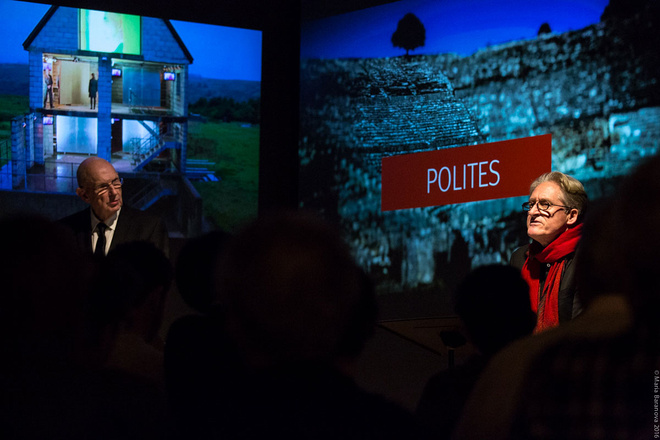
An artist-in-residence program at a graduate research institute? For nearly a quarter century Bard Graduate Center has been filling in dark spots on the map of learning and at the same time expanding the borders of that map. The new engagement with practicing artists, in different media, represents opening another kind of research platform, one that explores research through making, and highlights the deeply human impulses behind the study of material culture. It follows the call issued in 1975 by the philosopher Paul Feyerabend, who argued that “trying to establish a mode of research that unites their [the arts] power with that of science and religion seems to be a fascinating enterprise.” [Against Method, 281].
Pearson|Shanks arrived in early December for a week’s residency. Pearson the theater artist; Shanks the classical archaeologist. Their tool, for years, has been Theatre/Archaeology, bringing the the perspective of these two ways of knowing together to explore material remains or, as they put it “a practice that re-articulates fragments of the past as real-time event.” Percier’s ancient fantasies were both background and prompt, occasion and object of interpretation.
Lord of the dead, earth itself,
let him ascend from forgetfulness.
Let our Persian god, born in Susa,
rise from the dark slumber, below.
Release the divine Darius…
In the earliest recorded moment of Western drama—in Aeschylus’s The Persians—a ghost is summoned and appears…so says Welsh theater director and performance studies scholar Mike Pearson. Behind him the film of a somber black car driving through a rural dwelling flickers. The sky is grey—a typical Welsh winter. The film, an expertly shot version of Pearson’s large-scale site-specific production of The Persians, produced by the National Theater of Wales in an army barracks, will play throughout the performance. Standing beside Pearson is his colleague and creative collaborator Michael Shanks, an archeologist and former director of The Stanford Humanities Lab. Projected on the wall behind him is the word archaia, “Ta archaia are old things, and more—arche is originary principle, source of authority,” says Shanks. Upstairs is an exhibition devoted to the work of Charles Percier, a 19th century French architect who, along with his maybe lover, Pierre François Léonard Fontaine, helped establish Napoleon’s Imperial style, forever changing the architectural landscape of central Paris.
Over the next hour and half Pearson and Shanks stage a dialogue that uses, image, film, personal narrative and language to stage a kind of haunting, calling forth Marvin Carlson’s description of theater as “a simulacrum of the cultural and historical process … as a site for the continuing reinforcement of memory by surrogation.” For Carlson, theater is one of the most haunted of human cultural structures. With this Percier; too, becomes a haunted man, and his meticulous drawings and architectural designs a kind of haunting of classical antiquity in a later, non-classical age.
During the performance, time frames start to collapse in on themselves and the Bard Graduate Center Gallery, for the first time transformed into a black box theater, starts to feel like a burial site. Pearson narrates his live production of The Persians, the filmed version of which plays without pause; as ancient Greek words screen on the wall behind him, Shanks weaves descriptions of the power structures of classical antiquity with Percier’s imaginative replaying of them. Archaia—Chora—Polis—Phalanx—Polites—Theorema—Agora—Angelos—Eunomia—Ichnos—Pragmatogony. Pearson’s account of The Persians draws out themes of the cult of personality, the collapse of old order, the threat of regime change, and the incipient danger of reversion to barbarism and ritual. There is a striking resemblance to nineteenth-century France under the grasp of Napoleon, a connection made all the more uncanny by Napoleon’s penchant for a performance of power through a repurposed idea of classical architecture (enter Fontaine and Percier).
Over the arc of the three performances (Monday–Wednesday–Friday, with themes developed further during panel discussions on Tuesday and Thursday) Pearson and Shanks moved from the encounter with the past as mediated by the Persians, through a moving and visually arresting case study in the landscapes of the north of England, where both of them lived as children, before arriving back in the Bard Graduate Center’s Percier galleries on Friday night, when groups of audience members were engaged to make close observations and descriptions of their own encounters with antiquity. The real always lurks amidst the imagined.
